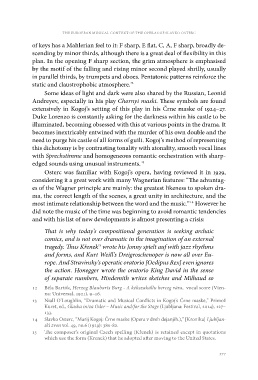Page 379 - Weiss, Jernej, ur. 2019. Vloga nacionalnih opernih gledališč v 20. in 21. stoletju - The Role of National Opera Houses in the 20th and 21st Centuries. Koper/Ljubljana: Založba Univerze na Primorskem in Festival Ljubljana. Studia musicologica Labacensia, 3
P. 379
the european musical context of the oper as of slavko osterc
of keys has a Mahlerian feel to it: F sharp, E flat, C, A, F sharp, broadly de-
scending by minor thirds, although there is a great deal of flexibility in this
plan. In the opening F sharp section, the grim atmosphere is emphasised
by the motif of the falling and rising minor second played shrilly, usually
in parallel thirds, by trumpets and oboes. Pentatonic patterns reinforce the
static and claustrophobic atmosphere.12
Some ideas of light and dark were also shared by the Russian, Leonid
Andreyev, especially in his play Chornyi maski. These symbols are found
extensively in Kogoj’s setting of this play in his Črne maske of 1924–27.
Duke Lorenzo is constantly asking for the darkness within his castle to be
illuminated, becoming obsessed with this at various points in the drama. It
becomes inextricably entwined with the murder of his own double and the
need to purge his castle of all forms of guilt. Kogoj’s method of representing
this dichotomy is by contrasting tonality with atonality, smooth vocal lines
with Sprechstimme and homogeneous romantic orchestration with sharp-
edged sounds using unusual instruments. 13
Osterc was familiar with Kogoj’s opera, having reviewed it in 1929,
considering it a great work with many Wagnerian features: “The advantag-
es of the Wagner principle are mainly: the greatest likeness to spoken dra-
ma, the correct length of the scenes, a great unity in architecture, and the
most intimate relationship between the word and the music.” 14 However he
did note the music of the time was beginning to avoid romantic tendencies
and with his list of new developments is almost presenting a crisis:
That is why today’s compositional generation is seeking archaic
comics, and is not over dramatic in the imagination of an external
tragedy. Thus Křenek15 wrote his Jonny spielt auf with jazz rhythms
and forms, and Kurt Weill’s Dreigroschenoper is now all over Eu-
rope. And Stravinsky’s operatic oratorio [Oedipus Rex] even ignores
the action. Honegger wrote the oratorio King David in the sense
of separate numbers, Hindemith writes sketches and Milhaud so
12 Béla Bartók, Herzog Blaubarts Burg - A kékszakállu herceg vára, vocal score (Vien-
na: Universal, 1921), 9–16.
13 Niall O’Loughlin, “Dramatic and Musical Conflicts in Kogoj’s Črne maske,” Primož
Kuret, ed., Glasba in/za Oder – Music and/for the Stage (Ljubljana: Festival, 2014), 127–
133.
14 Slavko Osterc, “Marij Kogoj: Črne maske (Opera v dveh dejanjih.),” [Kronika] Ljubljan-
ski zvon vol. 49, no.6 (1929): 380-82.
15 The composer’s original Czech spelling (Křenek) is retained except in quotations
which use the form (Krenek) that he adopted after moving to the United States.
377
of keys has a Mahlerian feel to it: F sharp, E flat, C, A, F sharp, broadly de-
scending by minor thirds, although there is a great deal of flexibility in this
plan. In the opening F sharp section, the grim atmosphere is emphasised
by the motif of the falling and rising minor second played shrilly, usually
in parallel thirds, by trumpets and oboes. Pentatonic patterns reinforce the
static and claustrophobic atmosphere.12
Some ideas of light and dark were also shared by the Russian, Leonid
Andreyev, especially in his play Chornyi maski. These symbols are found
extensively in Kogoj’s setting of this play in his Črne maske of 1924–27.
Duke Lorenzo is constantly asking for the darkness within his castle to be
illuminated, becoming obsessed with this at various points in the drama. It
becomes inextricably entwined with the murder of his own double and the
need to purge his castle of all forms of guilt. Kogoj’s method of representing
this dichotomy is by contrasting tonality with atonality, smooth vocal lines
with Sprechstimme and homogeneous romantic orchestration with sharp-
edged sounds using unusual instruments. 13
Osterc was familiar with Kogoj’s opera, having reviewed it in 1929,
considering it a great work with many Wagnerian features: “The advantag-
es of the Wagner principle are mainly: the greatest likeness to spoken dra-
ma, the correct length of the scenes, a great unity in architecture, and the
most intimate relationship between the word and the music.” 14 However he
did note the music of the time was beginning to avoid romantic tendencies
and with his list of new developments is almost presenting a crisis:
That is why today’s compositional generation is seeking archaic
comics, and is not over dramatic in the imagination of an external
tragedy. Thus Křenek15 wrote his Jonny spielt auf with jazz rhythms
and forms, and Kurt Weill’s Dreigroschenoper is now all over Eu-
rope. And Stravinsky’s operatic oratorio [Oedipus Rex] even ignores
the action. Honegger wrote the oratorio King David in the sense
of separate numbers, Hindemith writes sketches and Milhaud so
12 Béla Bartók, Herzog Blaubarts Burg - A kékszakállu herceg vára, vocal score (Vien-
na: Universal, 1921), 9–16.
13 Niall O’Loughlin, “Dramatic and Musical Conflicts in Kogoj’s Črne maske,” Primož
Kuret, ed., Glasba in/za Oder – Music and/for the Stage (Ljubljana: Festival, 2014), 127–
133.
14 Slavko Osterc, “Marij Kogoj: Črne maske (Opera v dveh dejanjih.),” [Kronika] Ljubljan-
ski zvon vol. 49, no.6 (1929): 380-82.
15 The composer’s original Czech spelling (Křenek) is retained except in quotations
which use the form (Krenek) that he adopted after moving to the United States.
377


